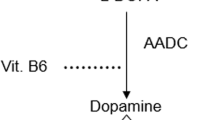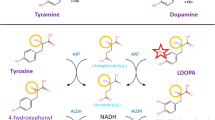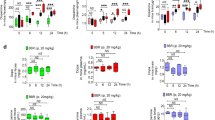Abstract
THE urinary output of m-hydroxyphenylacetic acid is increased during treatment of Parkinsonian patients with L-dopa1 and decreases significantly after administration of neomycin to reduce gut flora2. Thus, it seems that p-dehydroxylation of this type is achieved by intestinal microorganisms3. Whereas earlier animal experiments had suggested that 3,4-dihydroxy-phenylacetic acid is the immediate precursor of m-hydroxy-phenylacetic acid4, we now have evidence of increased m-tyramine formation, indicating that some degree of microbial dehydroxylation of dopamine or of L-dopa itself takes place.
This is a preview of subscription content, access via your institution
Access options
Subscribe to this journal
Receive 51 print issues and online access
$199.00 per year
only $3.90 per issue
Buy this article
- Purchase on SpringerLink
- Instant access to full article PDF
Prices may be subject to local taxes which are calculated during checkout
Similar content being viewed by others
References
Calne, D. B., Karoum, F., Ruthven, C. R. J., and Sandler, M., Brit. J. Pharmacol. Chemother., 37, 57 (1969).
Sandler, M., Karoum, F., Ruthven, C. R. J., and Calne, D. B., Science, 166, 1417 (1969).
Scheline, R. R., Acta Pharmacol. Toxicol., 26, 189 (1968).
DeEds, F., Booth, A. N., and Jones, F. T., J. Biol. Chem., 225, 615 (1957).
Block, R. J., Durrum, E. L., and Zweig, G., Manual of Paper Chromatography and Paper Electrophoresis, second ed. 132 (Academic Press, New York, 1958).
Kakimoto, Y., and Armstrong, M. D., J. Biol. Chem., 237, 208 (1962).
Perry, T. L., and Schroeder, W. A., J. Chromatog., 12, 358 (1963).
Coward, R. F., Smith, P., and Wilson, O. S., Clin. Chim. Acta, 9, 381 (1964).
Perez-Silva, G., Rodriguez, D., and Perez-Silva, J., Nature, 212, 303 (1966).
Ferrini, R., and Glässer, A., Biochem. Pharmacol., 13, 798 (1964).
Mitoma, C., Posner, H. S., Bogdanski, D. F., and Udenfriend, S., J. Pharmacol. Exp. Ther., 120, 188 (1957).
Blaschko, H., and Chruściel, T. L., J. Physiol., 151, 272 (1960).
Blaschko, H., Holton, P., and Sloane Stanley, G. H., J. Physiol., 108, 427 (1949).
Calne, D. B., and Sandler, M., Nature, 226, 21 (1970).
Carlsson, A., and Lindqvist, M., Europ. J. Pharmacol., 2, 187 (1967).
Andén, N.-E., Butcher, S. G., and Fuxe, K., Acta Pharmacol. Toxicol., 28, 39 (1970).
Carlsson, A., in Handbook of Experimental Pharmacology (edit. by Erspamer, V.), 19, 529 (Springer, Berlin, 1966).
Ehringer, H., and Hornykiewicz, O., Klin. Wschr., 38, 1236 (1960).
Sandler, M., Proc. Laurentian Meeting on Dopa in Parkinsonism (in the press).
Hornykiewicz, O., Proc. Laurentian Meeting on Dopa in Parkinsonism (in the press).
Sourkes, T. L., Biochem. Med., 3, 321 (1970).
Smith, R. L., Proc. Symposium on Mechanisms of Toxicity, London (in the press).
Calne, D. B., Stern, G. M., Laurence, D. R., Sharkey, J., and Armitage, P., Lancet, i, 744 (1969).
Author information
Authors and Affiliations
Rights and permissions
About this article
Cite this article
SANDLER, M., GOODWIN, B., RUTHVEN, C. et al. Therapeutic Implications in Parkinsonism of m-Tyramine Formation from L-Dopa in Man. Nature 229, 414–416 (1971). https://doi.org/10.1038/229414a0
Received:
Issue date:
DOI: https://doi.org/10.1038/229414a0
This article is cited by
-
Relationship Between the Gut Microbiome and Systemic Chemotherapy
Digestive Diseases and Sciences (2020)
-
Modulation of the Microbiome in Parkinson's Disease: Diet, Drug, Stool Transplant, and Beyond
Neurotherapeutics (2020)
-
The Microbiome in Neurodegenerative Disease
Current Geriatrics Reports (2018)
-
Effect of L-Dopa Therapy on Urinary p-Tyramine Excretion and EEG Changes in Parkinson's Disease
Nature (1972)
-
Threo-3,4-Dihydroxyphenylserine, a poor source of noradrenaline in the rat
Experientia (1972)



